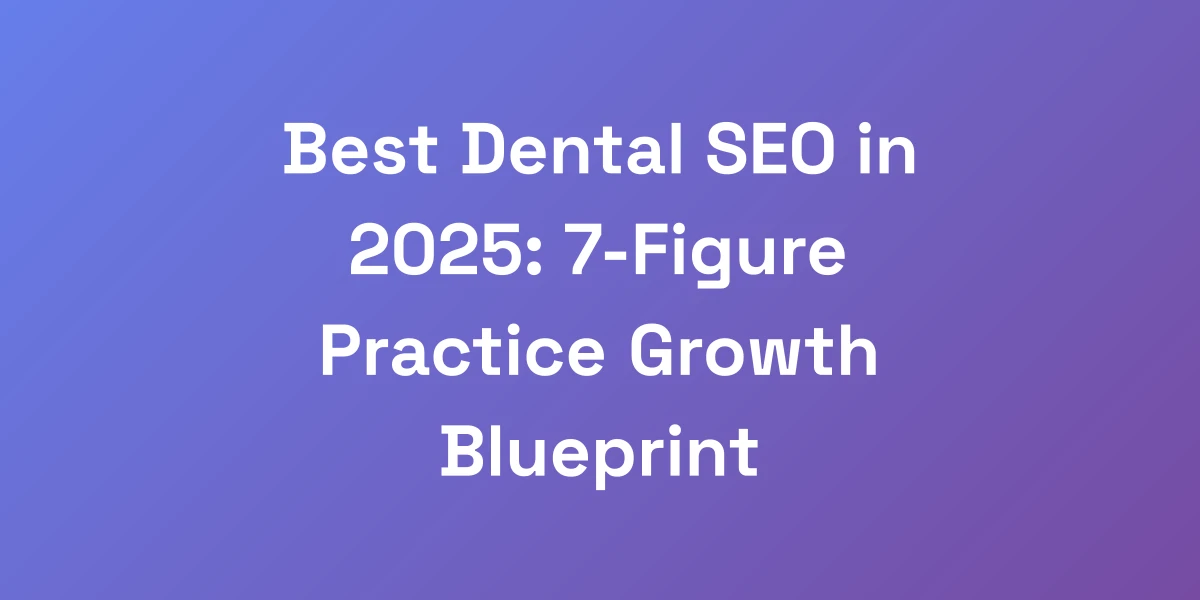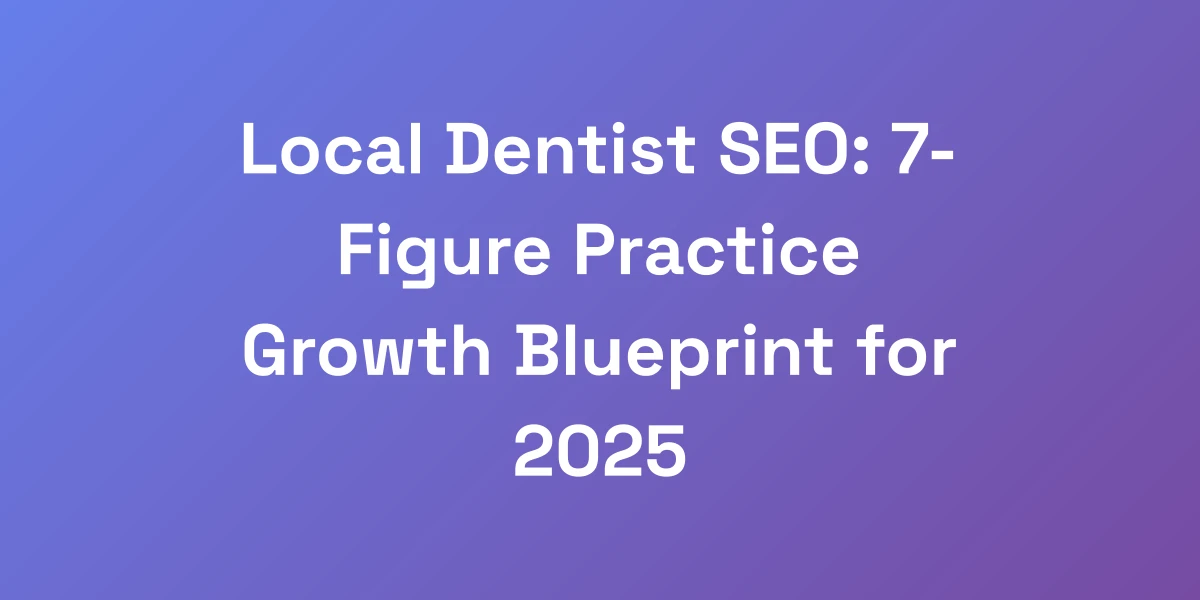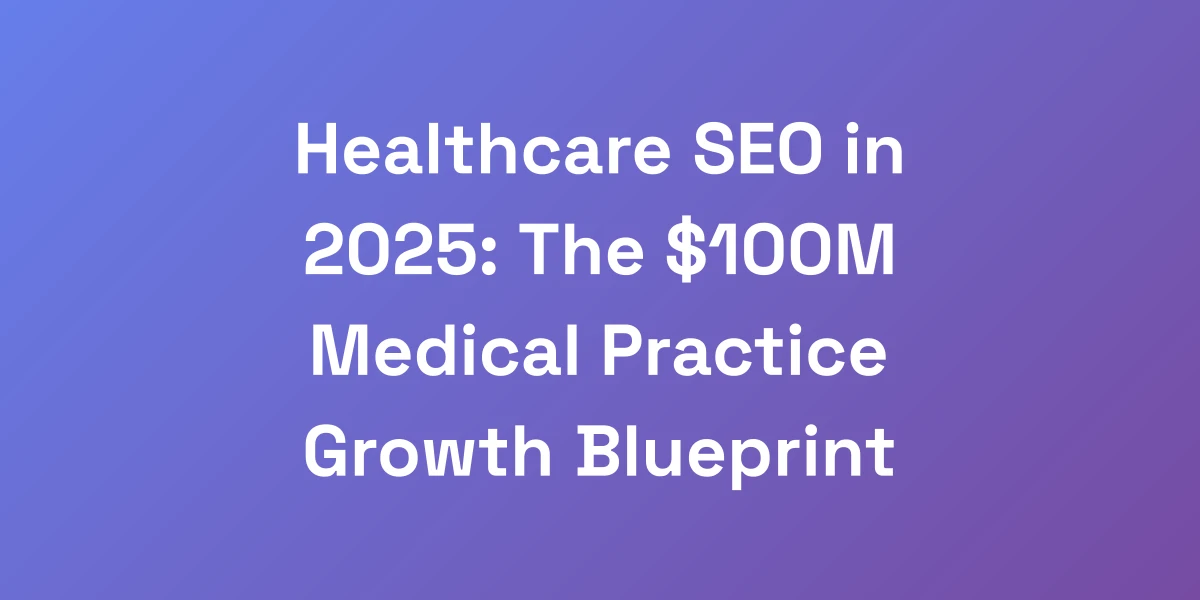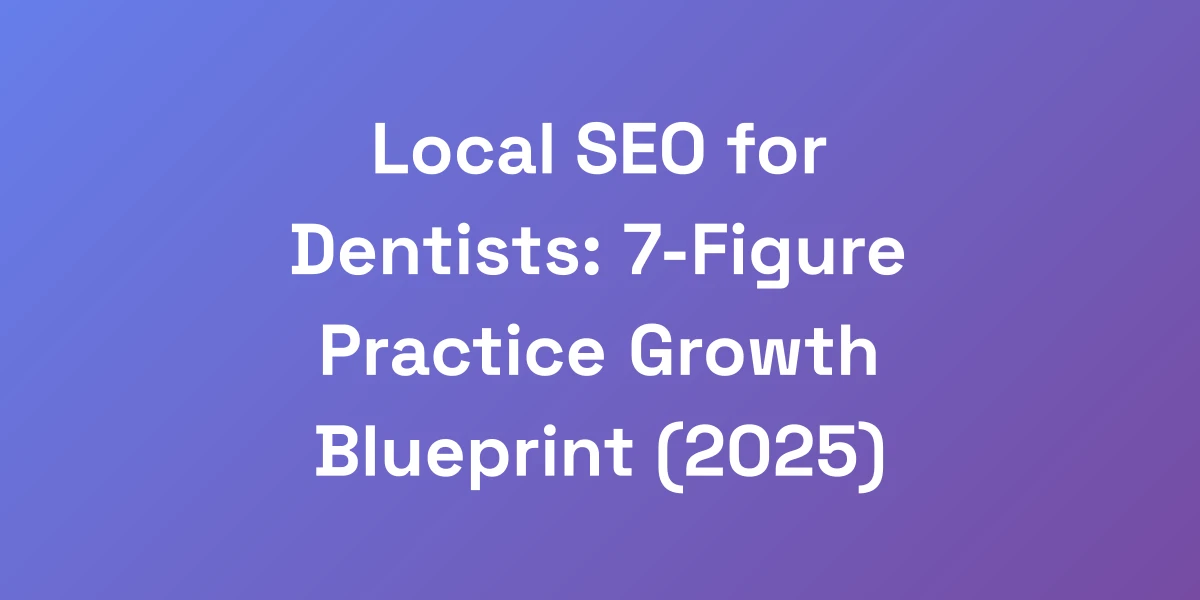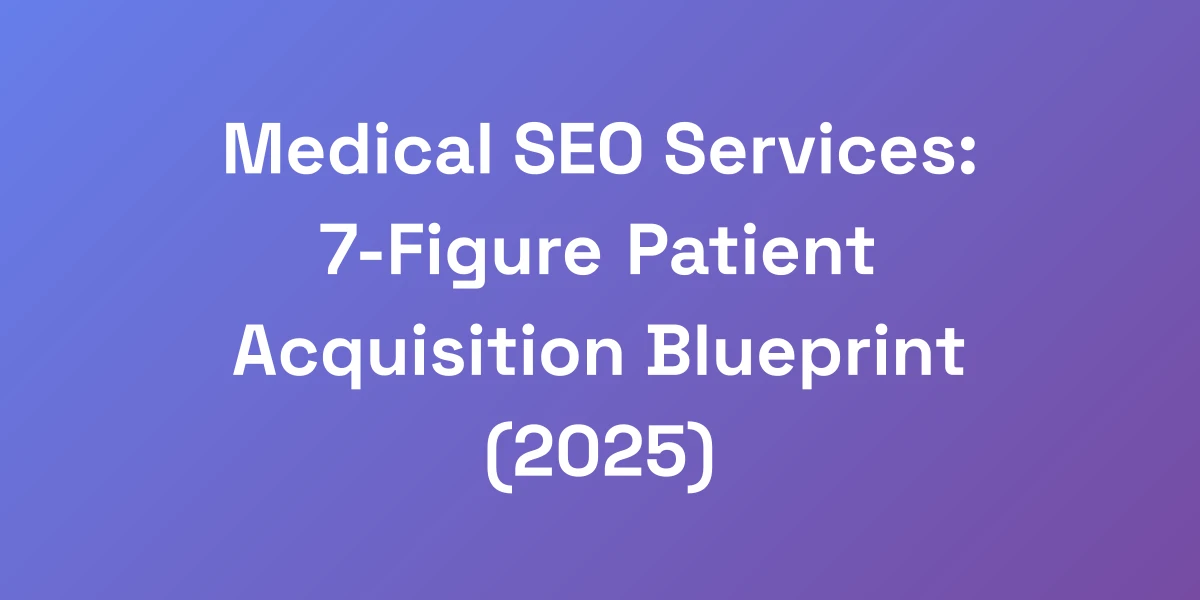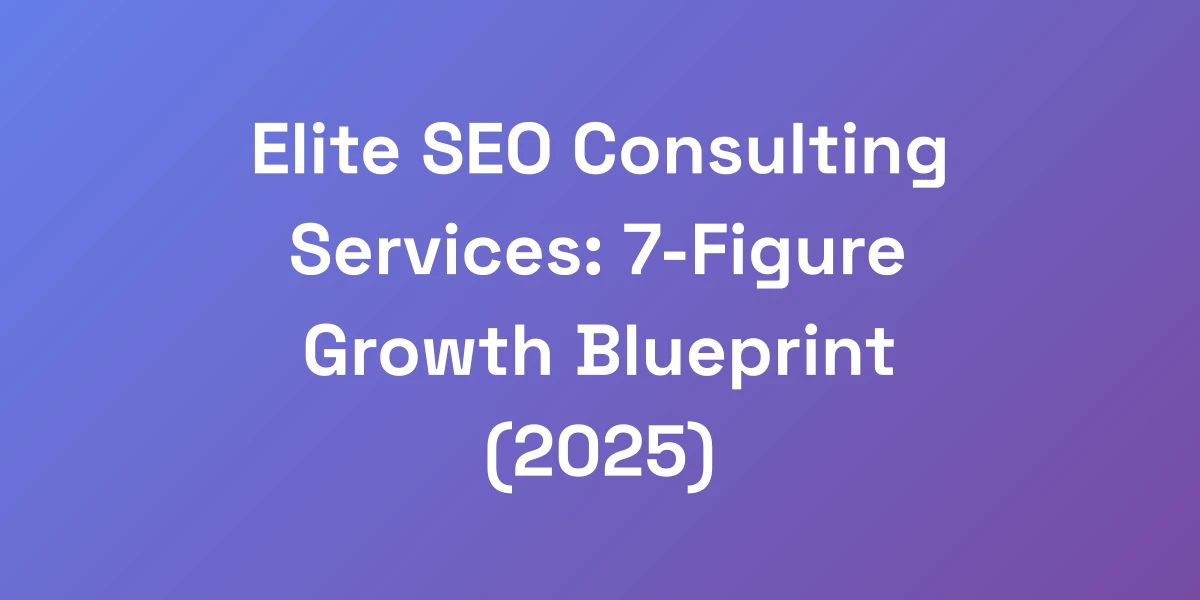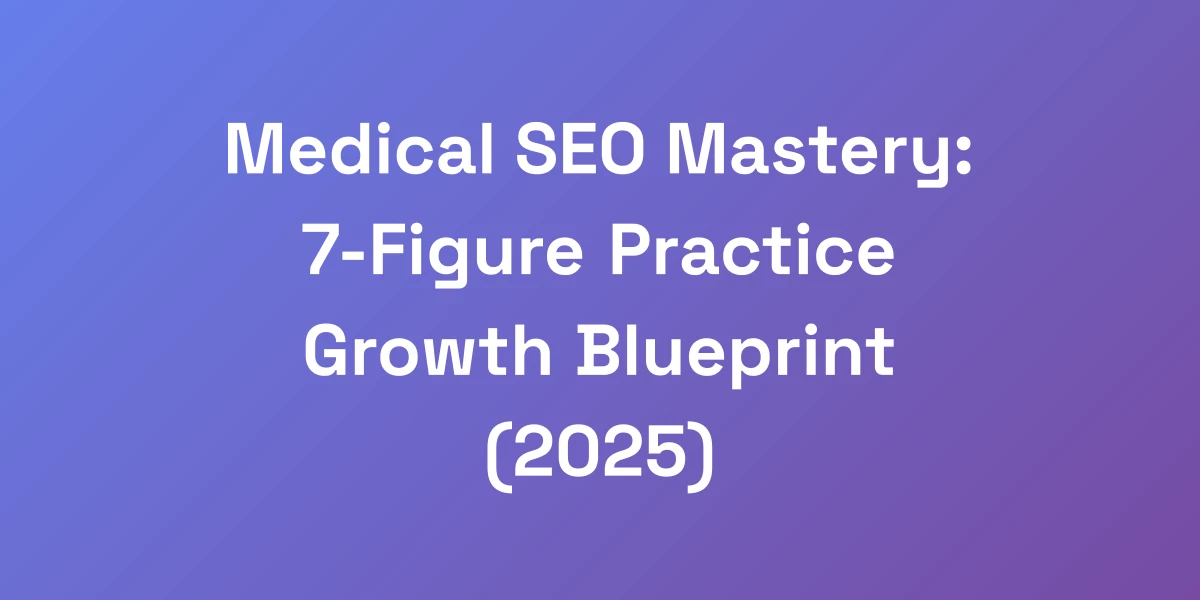
Medical SEO Mastery: 7-Figure Practice Growth Blueprint (2025)
Mar 5, 2025 | By [email protected]
Why Most Medical Practices Fail at SEO (And How to Fix It)
Let me be direct: 90% of medical practices are bleeding money by doing SEO wrong. I’ve consulted with hundreds of healthcare providers, and I keep seeing the same mistakes.
They focus on vanity metrics instead of patient acquisition. They chase random keywords instead of understanding search intent. And worst of all – they’re not leveraging their most valuable asset: their medical expertise.
Here’s the truth: medical SEO isn’t about gaming Google. It’s about positioning yourself as the undeniable authority in your field. Let me show you how to turn your medical practice into a patient-generating machine.
The Hidden Cost of Poor Medical SEO
Imagine investing thousands in SEO strategies that yield minimal results. That’s the hidden cost of poor medical SEO.
Most practices waste resources on tactics that don’t translate to patient acquisition. For example, focusing solely on high-traffic keywords without considering the relevance can attract visitors who never convert.
This misalignment leads to increased patient acquisition costs and reduced overall ROI. It’s not just about losing money; it’s about missing out on potential patients who could benefit from your services.
Common SEO Mistakes Healthcare Providers Make
Let’s break down the common pitfalls:
- Ignoring Local SEO: Failing to optimize for local searches means missing out on nearby patients actively seeking your services.
- Thin Content: Providing content that doesn’t address patient needs or answer their questions erodes your authority.
- Neglecting Mobile Optimization: With over 43% of the U.S. population using health apps, a non-mobile-friendly site is a death sentence.
- Poor Technical SEO: Slow loading speeds, broken links, and poor site structure frustrate users and harm your rankings.
Each of these mistakes not only hampers your SEO efforts but also drives potential patients straight to your competitors.
The Authority-First Approach to Medical SEO
To dominate the medical SEO landscape, adopt an authority-first approach. This means showcasing your expertise and building trust with both Google and your patients.
Start by creating high-quality, informative content that addresses patient pain points. Use real-life examples and case studies to demonstrate your expertise.
Implement structured data to help search engines understand your content better. This not only boosts your visibility but also positions you as a credible source in your field.
Case Study: How One Practice 10x’d Their Patient Flow
Take MedPark Hospital in Bangkok, for example. By creating thousands of new pages in both Thai and English, they achieved a 523% year-over-year growth in website traffic.
The English pages alone generated over 250,000 organic visits per month. This multilingual approach tapped into a broader audience, demonstrating the power of tailored content and strategic SEO implementation.
Another instance is the acupuncture clinic in Irvine, which saw a 310% increase in organic traffic within three months by optimizing service pages with targeted keywords and enhancing content quality.
These case studies prove that with the right strategies, exponential growth is not just possible—it’s attainable.
The New Rules of Medical SEO for 2025
As we approach 2025, medical SEO is evolving. Here are the new rules you need to follow:
- Focus on E-E-A-T: Expertise, Experience, Authoritativeness, and Trustworthiness are more critical than ever.
- Voice Search Optimization: With over 50% of the world’s population using voice search daily, optimizing for voice queries is essential.
- AI-Powered Tools: Leverage SEO automation tools for keyword research, content creation, and competitive analysis to stay ahead.
- Video SEO: Incorporate video content to enhance user engagement and convey complex medical information effectively.
Embracing these new rules will ensure your practice remains competitive and continues to attract a steady stream of patients.
Building Your Medical Practice’s SEO Foundation
Before you spend a single dollar on SEO, you need to get these fundamentals right. Most agencies won’t tell you this, but 80% of your SEO success happens before you even touch a keyword.
I’m talking about creating what I call the “Trust Triangle” – where your expertise, Google’s algorithms, and patient needs perfectly align. This isn’t theory – it’s the exact framework I’ve used to help medical practices generate millions in additional revenue.
Let’s break down the essential building blocks that will make or break your SEO success.
The Trust Triangle Framework
The Trust Triangle consists of three pillars:
- Expertise: Demonstrate your medical knowledge and authority through detailed, accurate content.
- Google’s Algorithms: Stay updated with Google’s ranking factors to ensure your site meets all technical requirements.
- Patient Needs: Understand and address what your patients are searching for, providing solutions and answers they need.
Balancing these pillars creates a robust SEO foundation that not only ranks well but also converts visitors into patients.
Essential Technical SEO for Medical Websites
Technical SEO is the backbone of your website’s performance. Here’s what you need to focus on:
- Site Speed: Ensure your website loads quickly to reduce bounce rates and improve user experience.
- Mobile Optimization: With a significant portion of patients using mobile devices, your site must be mobile-friendly.
- Secure Website (HTTPS): Security is paramount, especially for healthcare websites handling sensitive information.
- Clean URL Structure: Use clear and descriptive URLs that reflect the content and improve crawlability.
Neglecting technical SEO can severely hamper your rankings and user engagement, no matter how great your content is.
Content Architecture That Converts
Your website’s content architecture dictates how easily patients can find the information they need. Here’s how to optimize it:
- Logical Navigation: Organize your site with a clear hierarchy, making it easy for users to navigate.
- Internal Linking: Use internal links to guide visitors to related content, keeping them engaged longer.
- Content Silos: Group related content together to establish authority on specific medical topics.
A well-structured website not only enhances user experience but also boosts your SEO by making it easier for search engines to index your pages.
Local SEO Optimization for Healthcare
Local SEO is non-negotiable for medical practices. Here’s how to get it right:
- Google My Business: Optimize your profile with accurate information, photos, and patient reviews.
- Localized Content: Create content that addresses local health issues and incorporates local keywords.
- NAP Consistency: Ensure your Name, Address, and Phone number are consistent across all online platforms.
Local SEO helps you appear in search results when patients search for healthcare services in their vicinity, driving targeted traffic to your practice.
Mobile-First Medical Website Design
With 70% of the global population using mobile devices for health-related searches, a mobile-first design is crucial.
Here are actionable tips for mobile optimization:
- Responsive Design: Ensure your website adapts seamlessly to different screen sizes.
- Easy Navigation: Simplify menus and buttons for touch interactions.
- Fast Load Times: Optimize images and use efficient coding practices to speed up your site.
A mobile-optimized site enhances user experience, reduces bounce rates, and improves your rankings in mobile search results.
Schema Markup for Medical Practices
Implementing schema markup can significantly improve how your site appears in search results. Here’s how:
- MedicalCondition: Use this schema type to structure information about various medical conditions you treat.
- MedicalProcedure: Detail the procedures you offer with clear, structured data.
- MedicalSpecialty: Highlight your areas of expertise to improve your visibility in specialized searches.
Schema markup helps search engines understand your content better, leading to enhanced visibility through rich snippets and improved click-through rates.
Creating High-Converting Medical Content
Here’s what nobody tells you about medical content: it’s not about word count, it’s about patient transformation.
Your content needs to bridge the gap between medical expertise and patient understanding. I’ve developed a simple yet powerful content framework that has consistently generated 7-figure results for medical practices.
The secret? Creating content that serves both search engines and patients while positioning you as the only logical choice for treatment.
The Patient Journey Content Matrix
Map out your content based on the patient journey:
- Awareness Stage: Create informative blog posts and articles that address common health concerns.
- Consideration Stage: Develop detailed service pages and comparison guides to help patients evaluate their options.
- Decision Stage: Offer testimonials, case studies, and clear calls to action to convert visitors into patients.
Aligning your content with the patient journey ensures that you’re meeting their needs at every stage, enhancing engagement and conversion rates.
Writing for EAT (Expertise, Authority, Trust)
EAT is the backbone of medical SEO. Here’s how to excel:
- Showcase Expertise: Highlight your qualifications, certifications, and experience prominently on your website.
- Build Authority: Publish in-depth articles, research papers, and case studies that demonstrate your knowledge.
- Earn Trust: Display patient testimonials, secure your site with HTTPS, and ensure all information is accurate and up-to-date.
Enhancing your EAT signals not only improves your rankings but also builds trust with potential patients, making them more likely to choose your practice.
Content Types That Drive Patient Acquisition
Different types of content serve different purposes. Here’s what works best for medical practices:
- Blog Posts: Regularly updated blogs can target a range of keywords and address patient questions.
- Service Pages: Detailed pages about your services provide essential information and include targeted keywords.
- Case Studies: Showcase successful treatments and patient outcomes to build credibility.
- FAQs: Address common patient queries with concise, informative answers.
Using a mix of these content types ensures comprehensive coverage of patient needs and enhances your SEO effectiveness.
Video SEO for Medical Practices
Video content is a game-changer in medical SEO. Here’s why:
- Engagement: Videos can explain complex medical procedures in an easily digestible format.
- Retention: Patients retain 95% of a message when they watch it in a video, compared to only 10% when reading text.
- SEO Benefits: Videos increase time spent on your site, signaling to search engines that your content is valuable.
Incorporate videos such as patient testimonials, procedure explanations, and educational content to boost engagement and improve your SEO rankings.
User-Generated Content Strategies
Empower your patients to become your content creators:
- Testimonials and Reviews: Encourage satisfied patients to leave positive reviews on Google and your website.
- Patient Stories: Feature detailed stories of patient journeys to add authenticity and build trust.
- Q&A Sessions: Host live Q&A sessions where patients can ask questions, providing valuable content and fostering engagement.
User-generated content not only enriches your website but also enhances your credibility and trustworthiness in the eyes of both search engines and potential patients.
Content Distribution and Amplification
Creating great content is just half the battle. You need to ensure it’s seen by the right audience:
- Social Media: Share your content across platforms like Facebook, LinkedIn, and Twitter to reach a broader audience.
- Email Marketing: Distribute your content through newsletters to keep your patients informed and engaged.
- Backlink Building: Partner with reputable health websites to earn backlinks, boosting your domain authority.
Effective content distribution amplifies your reach, drives more traffic to your site, and enhances your SEO performance.
Advanced Medical SEO Tactics That Actually Work
Forget everything you’ve heard about “SEO best practices.” In the medical field, you need specialized tactics that align with Google’s heightened standards for health content.
I’m going to share the advanced strategies that are working right now – not theory, but battle-tested tactics that have generated real results for real medical practices. These are the same strategies that helped one of my clients go from 50 to 500 patient inquiries per month.
Featured Snippet Optimization for Medical Terms
Featured snippets are prime real estate in search results. Here’s how to secure them:
- Answer Specific Questions: Identify common medical queries and provide clear, concise answers.
- Use Structured Data: Implement schema markup to help Google understand your content better.
- Optimize for Zero-Click Searches: Ensure your content provides value even if users don’t click through.
By optimizing for featured snippets, you increase your visibility and position yourself as an authoritative source in your field.
Voice Search Optimization for Healthcare
With over 50% of the world’s population using voice search daily, optimizing for voice queries is essential:
- Natural Language Keywords: Incorporate conversational phrases that reflect how people speak.
- FAQ Pages: Create comprehensive FAQ sections that address common voice search queries.
- Local Optimization: Ensure your practice appears in local voice search results by optimizing for local SEO.
Voice search optimization enhances user experience and ensures your practice is easily discoverable through voice-activated devices.
Medical Knowledge Graph Optimization
Being featured in Google’s Knowledge Graph can significantly boost your visibility:
- Structured Data: Implement comprehensive schema markup to provide detailed information about your practice.
- Consistent NAP: Maintain consistency in your Name, Address, and Phone number across all platforms.
- Engage with Google My Business: Regularly update your profile with accurate information and respond to reviews.
Optimizing for the Knowledge Graph helps establish your practice’s credibility and ensures you’re prominently featured in search results.
Competitive Intelligence and Gap Analysis
Understanding your competition is key to staying ahead:
- Analyze Competitor Keywords: Identify the keywords your competitors are ranking for and find opportunities to target gaps.
- Content Gap Analysis: Determine what content your competitors are offering that you’re not, and fill those gaps.
- Monitor Backlinks: Track where your competitors are getting their backlinks and seek similar opportunities.
By conducting competitive intelligence and gap analysis, you can identify opportunities to outperform your competitors and capture more market share.
AI-Powered SEO Tools for Healthcare
Leverage SEO optimization automation to enhance your SEO efforts:
- Keyword Research: Use AI tools to identify high-performing keywords relevant to your practice.
- Content Optimization: AI can help refine your content for better readability and SEO performance.
- Predictive Analytics: Anticipate trends and adjust your strategies proactively.
AI-powered tools streamline your SEO processes, making your strategies more efficient and effective.
International Medical SEO Strategies
For practices targeting multilingual or international patients, here’s how to expand your reach:
- Multilingual Content: Create content in multiple languages to cater to diverse patient demographics.
- International Keyword Research: Identify and target keywords specific to different languages and regions.
- Global Schema Markup: Implement schema markup that accommodates international data and standards.
International SEO strategies enable your practice to attract a global patient base, tapping into new markets and expanding your reach.
Measuring and Scaling Your Medical SEO Success
If you can’t measure it, you can’t improve it. But here’s the catch – most medical practices are tracking the wrong metrics.
Understanding how long it takes for medical SEO to work is crucial for proper measurement.
Forget about generic rankings. What matters is patient acquisition cost and lifetime patient value.
I’ll show you exactly how to track the metrics that matter and scale what’s working. This is the same system I use to help practices consistently generate 6-7 figures in additional revenue through SEO.
Key Performance Indicators for Medical SEO
Focus on KPIs that directly impact your practice:
- Patient Acquisition Cost (PAC): Calculate how much it costs to acquire a single patient through your SEO efforts.
- Lifetime Patient Value (LPV): Estimate the total revenue a patient generates over their lifetime with your practice.
- Organic Traffic: Monitor the number of visitors coming from search engines to gauge your SEO performance.
Tracking these KPIs ensures you’re measuring the right aspects of your SEO strategy and can make informed decisions to enhance your growth.
ROI Tracking and Attribution
Understanding the return on investment is crucial:
- Attribution Models: Use models that accurately attribute conversions to your SEO efforts.
- Revenue Tracking: Link SEO activities directly to revenue generated from new patients.
- Cost-Benefit Analysis: Compare the costs of your SEO strategies against the revenue they generate.
Effective ROI tracking allows you to identify which strategies are most profitable and allocate resources accordingly.
Scaling Successful SEO Campaigns
Once you’ve identified what works, it’s time to scale:
- Increase Content Production: Publish more high-quality content to target additional keywords and topics.
- Expand Link Building: Focus on acquiring more high-authority backlinks to boost your site’s authority.
- Automate Processes: Use tools to automate repetitive tasks, freeing up time for strategic initiatives.
Scaling successful campaigns ensures sustained growth and maximizes the impact of your SEO investment.
Patient Journey Analytics
Deep dive into how patients interact with your website:
- Behavior Flow: Analyze the paths patients take through your site to identify friction points.
- Engagement Metrics: Measure metrics like time on site and bounce rate to assess content effectiveness.
- Conversion Funnels: Track the steps patients take to convert, from initial visit to appointment booking.
Understanding the patient journey helps you optimize your website for better user experience and higher conversion rates.
Conversion Rate Optimization
Turn more visitors into patients with these strategies:
- Clear CTAs: Use strong, clear calls to action to guide patients toward booking appointments.
- Streamlined Forms: Simplify contact and appointment forms to reduce friction and increase submissions.
- A/B Testing: Continuously test different elements of your site to determine what works best.
Optimizing your conversion rates ensures that your SEO efforts translate directly into practice growth.
Marketing Automation Integration
Enhance your SEO strategy with marketing automation:
- Email Campaigns: Automate follow-up emails to nurture leads and convert them into patients.
- Personalized Content: Use automation to deliver personalized content based on patient behavior and preferences.
- Lead Scoring: Implement lead scoring to prioritize high-potential patients for targeted outreach.
Marketing automation streamlines your processes, making your SEO strategy more effective and efficient.
Conclusion
We’ve navigated the complex world of medical SEO and uncovered the strategies that can transform your practice into a 7-figure revenue machine. From avoiding common pitfalls to building a solid SEO foundation, creating high-converting content, and implementing advanced tactics, each step is crucial in mastering SEO for your medical practice.
The key takeaways are clear: focus on patient acquisition over vanity metrics, leverage your medical expertise, and stay ahead of SEO trends. By adopting these strategies, you’re not just optimizing for search engines—you’re creating a trustworthy, authoritative presence that attracts and retains patients.
Ready to take your medical practice to new heights? Start implementing these strategies today and watch your patient flow—and revenue—soar.
Have you tried any of these SEO tactics in your practice? Share your experiences in the comments below or reach out to us to discuss how we can help you achieve 7-figure growth.
